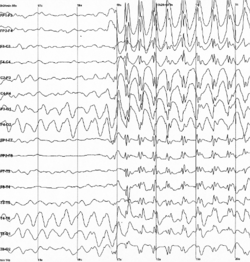Seizure

An epileptic seizure (colloquially a fit) is a brief episode of signs and/or symptoms due to abnormal excessive or synchronous neuronal activity in the brain.[1] The outward effect can vary from uncontrolled jerking movement (tonic-clonic seizure) to as subtle as a momentary loss of awareness (absence seizure). The disease of the brain characterized by an enduring predisposition to generate epileptic seizures is called epilepsy,[2][3] but seizures can also occur in people who do not have epilepsy.
This can occur due to a variety of causes and is common during withdrawals from prolonged chronic benzodiazepine usage or during an overdose on certain substances such as stimulants, synthetic cannabinoids and the 25x-NBOMe series of psychedelics.
See also
- Responsible use
- Subjective effects index
- Psychedelics - Subjective effects
- Dissociatives - Subjective effects
- Deliriants - Subjective effects
References
- ↑ Epileptic seizures and epilepsy: definitions proposed by the International League Against Epilepsy (ILAE) and the International Bureau for Epilepsy (IBE) (PubMed.gov / NCBI) | http://www.ncbi.nlm.nih.gov/pubmed/15816939
- ↑ Epileptic seizures and epilepsy: definitions proposed by the International League Against Epilepsy (ILAE) and the International Bureau for Epilepsy (IBE) (PubMed.gov / NCBI) | http://www.ncbi.nlm.nih.gov/pubmed/15816939
- ↑ ILAE official report: a practical clinical definition of epilepsy (PubMed.gov / NCBI) | http://www.ncbi.nlm.nih.gov/pubmed/24730690